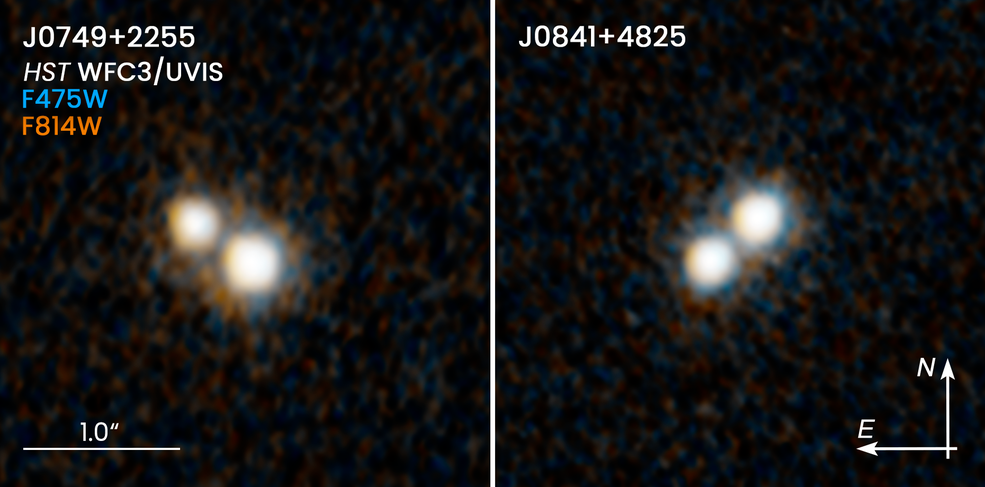NASA detects rare 'double quasar' in ancient corner of the universe
Finding this rare object was like 'a needle in a haystack,' the researchers said.

What burns brighter than a quasar — the hungry, supermassive black holes that outshine entire galaxies as they voraciously gobble up everything in reach?
How about a "double quasar?"
In a new study, astronomers used NASA's Hubble Space Telescope to peer 10 billion years into the cosmic past, where they detected two gargantuan quasars on the verge of colliding. Sitting at the centers of their respective galaxies, these hungry quasars have less than 10,000 light-years of breathing room between them, putting them far closer to each other than Earth's sun is to the center of the Milky Way (about 26,000 light-years away).
To ground-based telescopes, the quasar neighbors look like a single object — and one day, thanks to the unstoppable collision of their home galaxies, they will become one.
Related: Universe's oldest known quasar discovered 13 billion light-years away
This is not the first double quasar that astronomers have ever detected; according to the study authors, more than 100 have been discovered to date. However, the ancient pair of blazing lights is by far the oldest double quasar in the known universe. And in fact, it's not alone; in the same study, published April 1 in the journal Nature Astronomy, the researchers reported the detection of a second double quasar — also dating to 10 billion years ago.
"We estimate that in the distant universe, for every 1,000 quasars, there is one double quasar," lead study author Yue Shen of the University of Illinois at Urbana-Champaign, said in a statement. "So finding these double quasars is like finding a needle in a haystack."
Get the world’s most fascinating discoveries delivered straight to your inbox.
For their new study, the researchers picked their haystacks carefully. The team focused their search on the distant universe, as star formation is thought to have peaked in the universe about 10 billion years ago, and galactic mergers were much more common then, the authors said. These mergers funneled huge amounts of matter toward the black holes lurking in the cores of galaxies; As those black holes sucked in matter at near-light-speed, they released a flood of radiation, becoming quasars.
Quasars can outshine large galaxies, though their brightness may fluctuate every few days, weeks or months, depending on how much matter they're gobbling up at the time. Because of this finicky eating schedule, a double quasar may appear to "jiggle" in place when one member of the pair brightens or dims while the other remains static. With the help of the Gaia space observatory and Sloan Digital Sky Survey, the study authors targeted several jiggling quasars in the distant universe, then zoomed in with the Hubble telescope.
Two of these jiggling light sources turned out to be the ancient double quasars, flickering toward their inevitable collisions.
According to the researchers, studying merging quasars can help them understand the nuances of galaxy formation — and destruction. As quasars grow, their radiation can generate powerful winds that may ultimately blow all of the star-forming gas out of their way. When this gas is gone, star formation ends and the galaxies that house the quasars enter early retirement, slowly waiting for all their old stars to burn out and fade away.
"Quasars make a profound impact on galaxy formation in the universe," study co-author Nadia Zakamska of Johns Hopkins University in Baltimore, Maryland, said in the statement. "Finding dual quasars at this early epoch is important because we can now test our long-standing ideas of how black holes and their host galaxies evolve together."
Originally published on Live Science.

Brandon is the space / physics editor at Live Science. With more than 20 years of editorial experience, his writing has appeared in The Washington Post, Reader's Digest, CBS.com, the Richard Dawkins Foundation website and other outlets. He holds a bachelor's degree in creative writing from the University of Arizona, with minors in journalism and media arts. His interests include black holes, asteroids and comets, and the search for extraterrestrial life.



